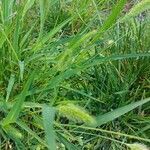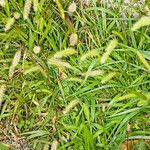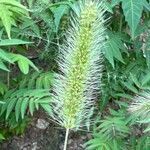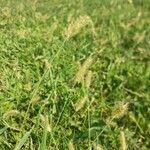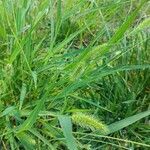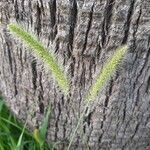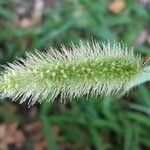Annual 2–25 dm; sheaths ciliate along the upper margins; blades flat, up to 40 × 2.5 cm, scabrous above, glabrous or scaberulous beneath; infl erect or slightly nodding near the tip, cylindric, the axis hispid and densely villous, the branches not verticillate; spikelets 1.6–2.5 mm; first glume a third the length of the spikelet, 3-veined, the second nearly equaling the spikelet, 5–6-veined; sterile lemma slightly surpassing the fertile one, with a narrow, hyaline palea a third as long; fertile lemma very pale green and transversely very finely rugulose; 2n=36. A cosmop. weed, mostly of temp. regions, found in fields, gardens, and waste places throughout our range. Most of our plants belong to var. viridis, 2–10 dm, with lvs up to 20 cm × 12 mm, the infl 3–10(–15) cm, not lobed. The less common var. major (Gaudin) Peterm. is vegetatively larger, 15–25 dm, with lvs to 40 × 2.5 cm, the infl to 20 cm and somewhat lobulate. It may reflect introgression from no. 6 [Setaria italica (L.) P. Beauv.].
Annual. Culms tufted, erect or geniculate, up to 70(–150) cm tall, 3–7 mm in diam. Leaf sheaths glabrous to papillose-pilose, margins densely ciliate; leaf blades linear to linear-lanceolate, flat, glabrous or papillose-pilose on both surfaces, base subrounded or subtruncate, margins scabrous, apex acuminate; ligule 1–2 mm. Panicle dense, usually cylindrical, usually tapering upward, 1–24 cm, erect or slightly nodding, branchlets bearing several spikelets each subtended by 3–7(–25) bristles; axis pilose or pubescent; bristles green, brown or purple, 4–12 mm. Spikelets elliptic-oblong, 2–2.5(–3) mm, obtuse; lower glume 1/4–1/3 as long as spikelet, obtuse or rarely acute; upper glume elliptic, as long as spikelet, lower lemma equal to spikelet; lower palea about 1/3 as long as lemma; upper lemma pale green, oblong, finely punctate-rugose, obtuse. Fl. and fr. May–Oct. 2n = 18.
An annual grass. It forms tufts. It can be 70-150 cm tall. The culms are usually bent at the lower nodes. The leaf blades are thin and flat in cross section. They are 5-30 cm long and 3-12 mm wide. The taper to a fine point. The flowers are bristly. The teeth of the bristles point upwards. It is similar to Setaria verticillata except for some flower details.
